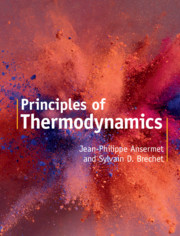8 - Chemistry and Electrochemistry
from Part II - Phenomenology
Published online by Cambridge University Press: 14 December 2018
Summary
The stoichiometric coefficients and the extent of a reaction are defined. The affinity is defined in terms of chemical potentials and the corresponding Gibbs free energy and enthalpy of a reaction. The affinity can be expressed as a derivative in analogy with a force that is a derivative of a potential. Dissipation or internal entropy production occurs when chemical reactions take place. The extensivity of volume, entropy and enthalpy implies that molar volume, entropy and enthalpy can be defined for every substance present in a system. In view of the chemical potential dependence on partial pressure in a mixture of ideal gases, the chemical potential of an ideal mixture is defined. From it, the law of mass action is derived and osmosis can be understood. In electrochemistry, the Nernst potential potential can be obtained by considering the equilibrium conditions on the chemical potentials of electrons and ions at both electrodes. The working principle of a Daniell battery is analysed in detail. The second law implies phenomenological laws of transport in a thermogalvanic cell. The principle of an osmotic power plant can be understood by applying the van't Hoff estimate of an osmotic pressure.
Keywords
- Type
- Chapter
- Information
- Principles of Thermodynamics , pp. 203 - 238Publisher: Cambridge University PressPrint publication year: 2019

